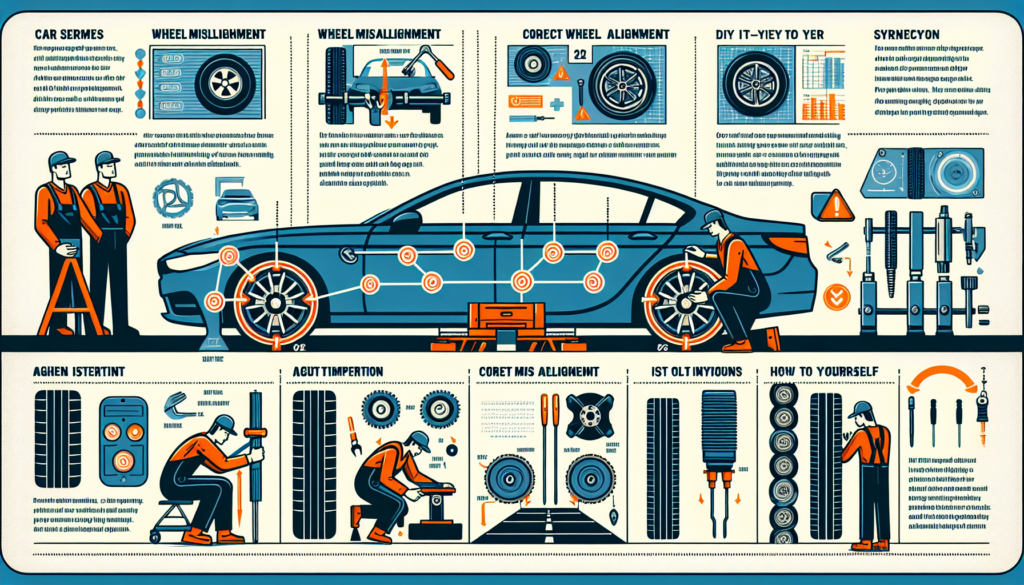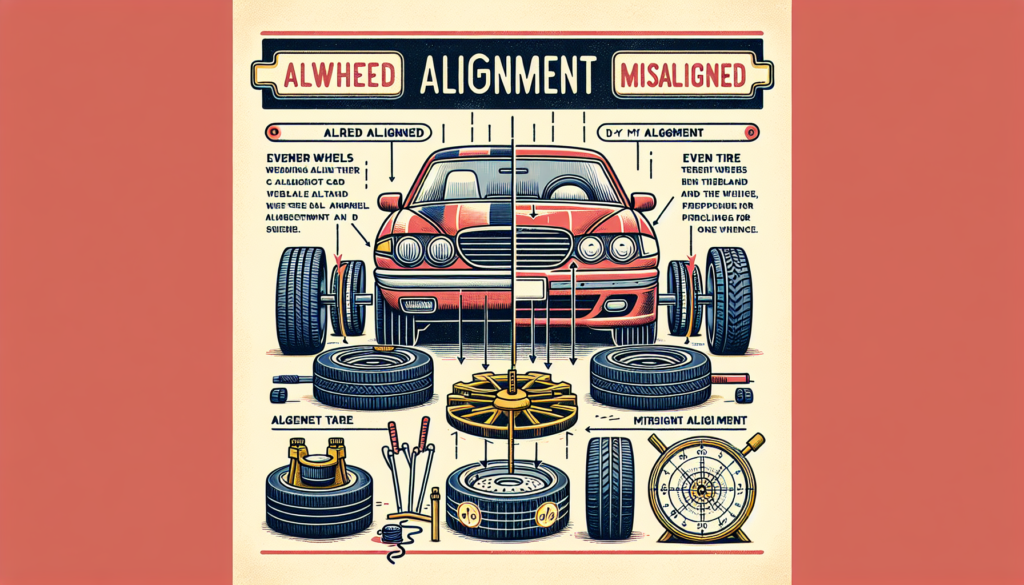So, you’ve recently had your car serviced, and now you’re wondering if your wheels are properly aligned. It’s a valid concern, as misaligned wheels can lead to various issues like uneven tire wear and poor handling. But don’t worry, because in this article, we’ll guide you on how to determine whether your wheels are aligned correctly after servicing. By paying attention to certain signs and conducting a simple test, you’ll be able to ensure that your wheels are aligned and your ride is smooth and safe.
Visual Inspection
Checking for Uneven or Excessive Tire Wear
When assessing the alignment of your wheels, one of the first signs to look out for is uneven or excessive tire wear. Inspect each tire carefully and observe if there are any areas of wear that are more pronounced than others. Uneven tire wear often indicates misalignment. Additionally, be on the lookout for excessive wear on the outer edges or center of the tires, as these can also be signs of misalignment.
Assessing the Direction of Pull
Another visual cue that can help determine if your wheels are aligned is assessing the direction of pull while driving. When driving on a straight road, pay attention to whether your vehicle tends to drift to one side or the other. If you find yourself constantly adjusting the steering wheel to maintain a straight path, it may suggest that your wheels are misaligned.
Examining the Steering Wheel Position
Take a moment to inspect the position of your steering wheel. While driving on a level road, the steering wheel should be centered and aligned with the vehicle’s emblem. If you notice that the steering wheel is off-center, it could be an indication of misalignment. However, keep in mind that a slightly off-center steering wheel could also be a result of tire rotation or other factors. Therefore, it’s important to consider other signs and symptoms together when assessing wheel alignment.
Driving Sensations
Observing Vehicle Drift
When driving, pay attention to any drifting sensations you may experience. If your vehicle tends to veer or pull to one side, even when the road appears to be straight, it could be a sign of misaligned wheels. This can be particularly noticeable when you momentarily remove your hands from the steering wheel, as the vehicle may veer in a specific direction.
Noticing Steering Vibrations
Steering vibrations can be another indicator of wheel misalignment. If you feel vibrations or a shaking sensation through the steering wheel while driving, it’s important to investigate the cause. Misaligned wheels can create uneven tire contact with the road surface, leading to vibrations being transferred through the steering system. However, it’s worth noting that vibrations can also be caused by other factors such as tire balance or worn suspension components, so a thorough inspection is recommended.
Detecting Changes in Handling
Changes in the way your vehicle handles can also provide insight into wheel alignment issues. If you notice that the vehicle feels “loose” or tends to wander while driving, it could indicate misaligned wheels. Similarly, if you experience difficulties in maintaining control or stability, especially during turns or sudden maneuvers, it may be time to check your wheel alignment.

Using a Tread Depth Gauge
Measuring Tread Depth
To assess the condition of your tires and potentially identify alignment issues, a tread depth gauge can be a useful tool. Start by measuring the tread depth of each tire. Place the gauge in the tread grooves and take note of the readings. If you find significant variations in tread depth across the same tire or between different tires, it could suggest uneven weight distribution resulting from misalignment.
Comparing Tread Depth Across Tires
Equally important is comparing the tread depth among all four tires. If you notice that one tire has considerably less tread depth compared to the others, it may indicate misaligned wheels, as misaligned tires tend to wear unevenly. Keep in mind that tires wearing out at different rates can also be influenced by factors such as tire rotation patterns or improper inflation. Therefore, tread depth should be considered alongside other alignment symptoms.
Inspecting Tire Pressure
Checking Tire Pressure with a Gauge
Proper tire pressure is crucial for optimal alignment and tire wear. To determine if your wheels are aligned after servicing, it’s important to check the tire pressure using a reliable gauge. Ensure your tires are cold, as tire pressure can increase while driving. Refer to the manufacturer’s recommended tire pressure, usually found in the vehicle’s manual or on a sticker inside the driver’s door frame. Compare the measured pressure to the recommended value to ensure it falls within the acceptable range.
Ensuring Proper Inflation
Maintaining proper tire inflation is vital not only for alignment but also for your vehicle’s overall performance and safety. Overinflated or underinflated tires can affect handling, fuel efficiency, and tire wear. After confirming that your tire pressures are correct, monitor them regularly and adjust as needed. By keeping your tires properly inflated, you can help maintain wheel alignment and extend the lifespan of your tires.

Testing Wheel Alignment with a DIY String Method
Setting Up the String Method
If you prefer a do-it-yourself approach to check your wheel alignment, you can utilize the string method. This method requires a straight and level space, such as a garage floor or driveway. Begin by positioning your vehicle on this surface and marking the center of the front and rear tires. Next, attach two parallel strings on each side of the vehicle, running along the length of the vehicle. Ensure the strings are taut and aligned with the center markings.
Measuring Distance from Tread Edge to String
With the strings in place, measure the distance from the edge of each front tire’s tread to the string on the corresponding side. Repeat this process for the rear tires. All four measurements should be relatively equal if your wheels are properly aligned. Significant deviations between the distances could indicate misalignment.
Analyzing Deviations from Ideal Measurements
When analyzing the measurements taken with the string method, it’s important to note that small variations can be expected due to manufacturing tolerances and other factors. However, if you notice consistent and significant differences amongst the measurements, it may suggest that your wheels require adjustment. If you’re unsure how to interpret the measurements accurately, consulting a professional alignment technician is advisable.
Using a Commercial Wheel Alignment Tool
Investing in a Wheel Alignment Tool
For a more precise and advanced approach, investing in a commercial wheel alignment tool can be an option. These tools are designed to provide accurate measurements and diagnose alignment issues quickly. Depending on your budget and level of expertise, you can opt for a basic tool for personal use or a more sophisticated model for professional-grade results.
Following the Manufacturer’s Instructions
Once you have a wheel alignment tool, carefully read and follow the manufacturer’s instructions for accurate measurement and diagnosis. These tools often rely on sensors, lasers, or cameras to assess various alignment angles such as toe, camber, and caster. Make sure to measure all four wheels and compare the values to the manufacturer’s recommended specifications.
Interpreting the Diagnostic Results
After using a commercial wheel alignment tool, you will receive diagnostic results indicating the current alignment status of your wheels. These results may include measurements for toe, camber, and caster angles. Compare the obtained values to the manufacturer’s recommended specifications for your specific vehicle model. If the measurements deviate significantly from the recommendations, it may be necessary to consult a professional alignment technician for further adjustment.

Seeking Professional Wheel Alignment Service
Understanding the Benefits of Professional Alignment
While DIY methods can provide initial insights, seeking professional wheel alignment service has numerous advantages. Alignment technicians possess specialized knowledge, experience, and advanced equipment to accurately diagnose and adjust your vehicle’s alignment. Professional alignment ensures that your wheels are precisely aligned according to the manufacturer’s specifications, optimizing handling, tire wear, and overall driving experience.
Choosing a Reliable Alignment Service Provider
When selecting a wheel alignment service provider, consider factors such as reputation, expertise, and customer reviews. Look for alignment shops that employ certified technicians and use state-of-the-art equipment. Additionally, reputable shops often provide warranties on their alignment services, giving you peace of mind in case any issues arise after the alignment.
Considering Post-Service Test Drive
Following a professional wheel alignment, take your vehicle for a test drive to assess the results. Pay attention to any improvements in steering response, stability, and overall handling. If you notice a significant difference in how your vehicle performs or if any alignment-related issues persist, contact the alignment service provider to address the concerns promptly. Timely communication can help resolve any potential alignment issues that may have been missed during the initial service.
Monitoring Vehicle’s Fuel Efficiency
Noting Changes in Fuel Consumption
Wheel misalignment can impact your vehicle’s fuel efficiency. If you notice an unexpected decrease in gas mileage, it could suggest that your wheels are not aligned properly. Misaligned wheels can cause increased rolling resistance, resulting in more energy required to propel the vehicle forward. By monitoring your vehicle’s fuel consumption and addressing any changes promptly, you can potentially improve fuel efficiency and save money on fuel expenses.
Assessing the Impact of Wheel Misalignment
When assessing the impact of wheel misalignment on fuel efficiency, it’s essential to consider other factors that can influence fuel consumption as well. Factors such as driving conditions, traffic patterns, tire pressure, and vehicle maintenance can all play a role in fuel efficiency. However, if you notice a significant and persistent decrease in fuel efficiency without any other apparent causes, it’s worth considering checking your wheel alignment as part of the troubleshooting process.

Examining Suspension Components
Evaluating Uneven Wear on Suspension Components
In addition to tire wear, misaligned wheels can also contribute to uneven wear on suspension components. Inspect the suspension components, including control arms, ball joints, and bushings, for any signs of excessive wear or damage. Uneven wear patterns on these components may suggest prolonged misalignment, causing unnecessary stress and premature degradation. Consult a professional technician if you suspect any suspension issues or need assistance with inspection.
Checking for Damaged or Worn Parts
During your visual inspection, take note of any damaged or worn parts within the suspension system. Be on the lookout for signs of corrosion, cracks, or excessive play in the components. Damaged or worn suspension parts can adversely affect wheel alignment and overall vehicle performance. If you suspect any issues, it’s crucial to address them promptly to prevent further damage and ensure optimal alignment.
Consulting the Vehicle Owner’s Manual
Reviewing the Wheel Alignment Section
For comprehensive and accurate information regarding your specific vehicle’s wheel alignment, consult the vehicle owner’s manual. The manual usually contains a dedicated section that provides recommendations and guidelines on wheel alignment. Pay attention to any alignment specifications, maintenance schedules, and other relevant information provided by the manufacturer.
Following Manufacturer’s Recommendations
The manufacturer’s recommendations are tailored to ensure the best performance and longevity of your vehicle. Adhering to these recommendations will help you maintain proper wheel alignment throughout the lifespan of your vehicle. Follow the maintenance schedules, including regular inspections and alignments, as advised by the manufacturer. By doing so, you can extend the life of your tires, improve driving comfort, and minimize potential alignment-related issues.
In conclusion, there are several signs and methods to determine if your wheels are aligned after servicing. Visual inspection, driving sensations, tread depth gauge measurement, tire pressure inspection, DIY string method, commercial alignment tools, professional alignment service, fuel efficiency monitoring, suspension component examination, and consulting the vehicle owner’s manual are all valuable approaches to ensure your wheels are properly aligned. Regular attention to wheel alignment not only improves handling and safety but also promotes optimal tire wear and overall vehicle performance. By familiarizing yourself with these techniques, you can effectively assess the condition of your wheels and address any alignment issues promptly. Remember, maintaining proper alignment is essential in maximizing the lifespan and efficiency of your tires, as well as ensuring a smooth and enjoyable driving experience.


